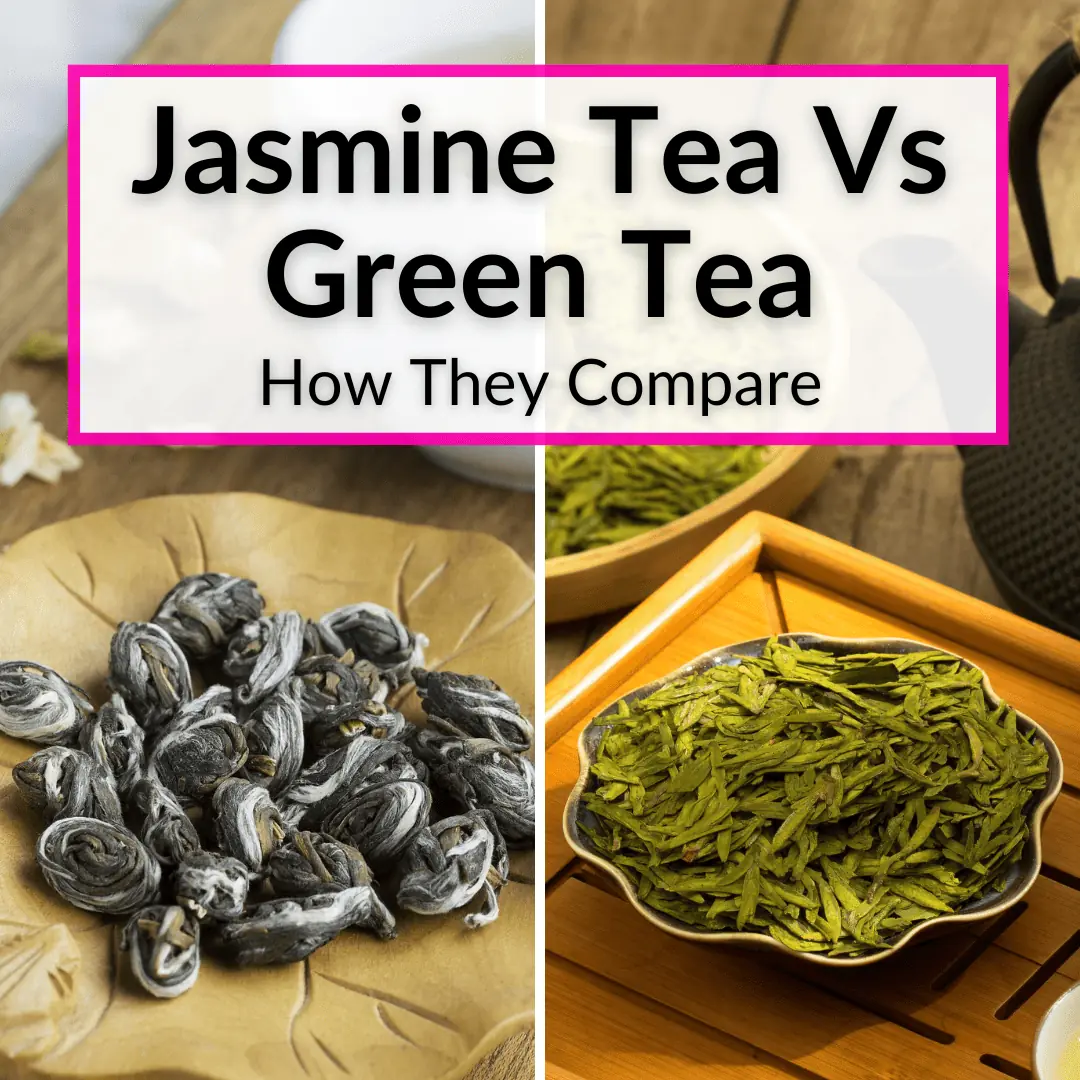 There is a good deal of confusion when comparing jasmine tea vs green tea.
There is a good deal of confusion when comparing jasmine tea vs green tea.
That’s mainly because jasmine tea is a type of green tea.
Sometimes.
And sometimes it isn’t.
As we will soon see, jasmine tea can have various teas as its base. Or none at all.
So what does all of this mean to us tea drinkers?
Keep reading to find out. We are going to compare green tea and jasmine tea in depth and help you figure out which one is best for you. Of course, you can also just drink both. That’s what I do!
Table of Contents
- 1 Jasmine Tea Vs Green Tea
- 2 Is Jasmine Tea Green Tea?
- 3 Green Tea Vs Jasmine Tea: Final Thoughts
Jasmine Tea Vs Green Tea
We will begin our comparison of green tea vs jasmine tea by looking at each type of tea individually, before comparing them directly. We will discuss the advantages of each type and help you figure out which one to get.
Jasmine Tea
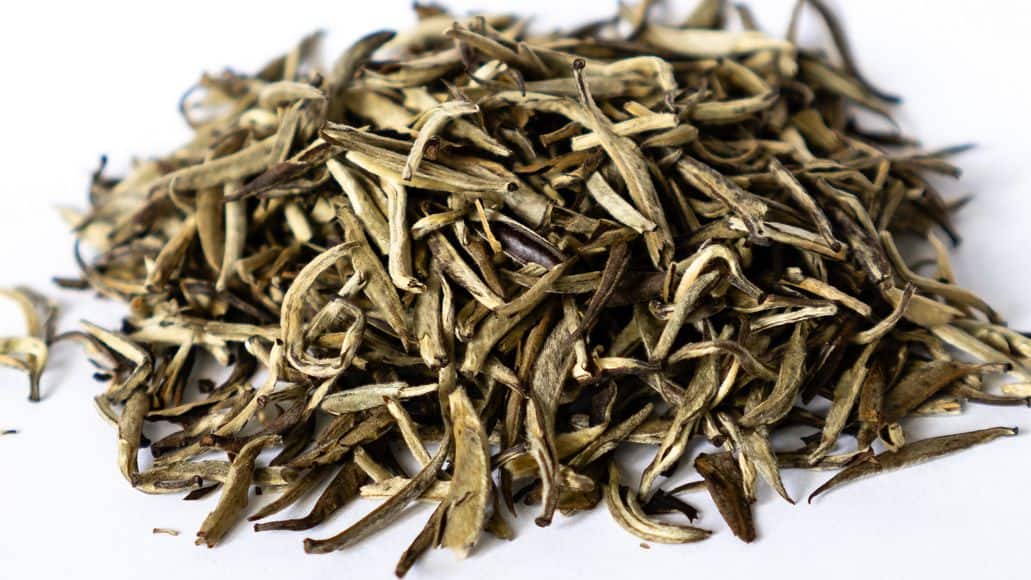
Jasmine tea is a fragrant Chinese tea made using the blossoms of the Jasmine plant. There is some evidence to suggest it was first discovered in China during the Song Dynasty (960 -1127 AD). However, China only began cultivating jasmine tea much later: it was after its popularity grew in the West.
In general, any tea that has been fragranced or flavored with jasmine blossoms (a small white flower that grows on a vine belonging to the olive family) can be considered jasmine tea.
Thus, you can have jasmine tea with any base, such as green, white, or black tea. Today, the majority of brands use green or white tea as the base for jasmine tea.
Pure jasmine tea is made with just the blossoms and is thus not ‘tea’ in the traditional sense. This also makes it caffeine-free.
There are several methods of marrying the jasmine flavor with its base tea and these can be artificial or natural. Artificial methods impart a fake or inconsistent flavor to the final product, whereas natural methods make the tea more flavorful and pleasant.
Jasmine tea has many health benefits and has been used in Traditional Chinese Medicine, or TCM, to cure a wide range of ailments. The amount of caffeine in jasmine tea is also a lot less compared to a lot of other teas (although the exact quantity depends on the basal tea used).
Green Tea
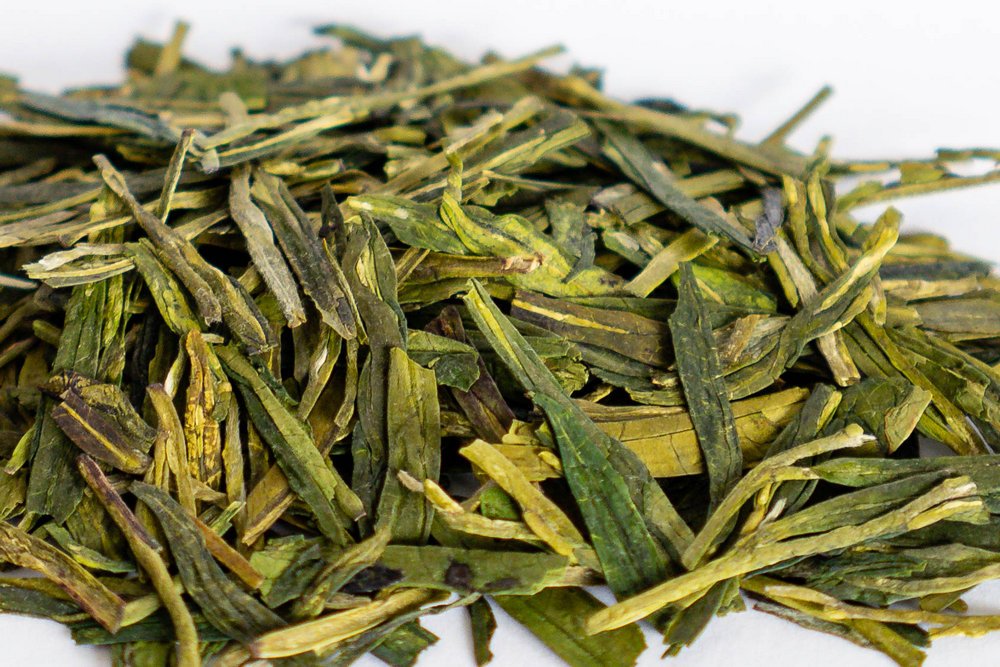
Green tea was first discovered in 2737 BC in China. It is believed that the Chinese Emperor Shennong accidentally boiled a dead tea leaf in water and found the beverage refreshing.
In its early days, green tea was only available to the royals and nobles in China. It was only after the late 13th Century that the beverage became accessible to common people for daily use and medicinal purposes.
Green tea comes from the Camelia sinensis plant. The tea leaves are protected from further oxidation through a shorter drying process. This enhances the tea’s antioxidant content and also imparts a greener color to it.
Today, the best green teas come from Japan and China. Both nations have different methods of processing the tea leaves.
Chinese green teas are generally pan-fired or roasted in a wok, whereas Japanese green teas are primarily deep-steamed. These different processing methods have given rise to a wide variety of green teas.
Green tea is hailed as a superfood today. It has a high concentration of antioxidants, chlorophyll, and polyphenols. Considering all the benefits green tea provides, some say say that green tea is the healthiest beverage on the planet.
Difference Between Jasmine Tea And Green Tea
There are a number of key differences between jasmine teas and green teas. This is true even for jasmine teas that are made with green tea leaves a the base. Let’s take a look.
Flavor

Jasmine tea is fragrant and aromatic. Its flavor can be described as floral, mellow, sweet, and subtle.
Green tea’s flavor can be described as nutty, grassy, vegetal, or earthy. Of course, you can get green tea in a variety of flavors these days.
Base
Jasmine tea is made using green, white, black, or oolong teas as its base, combined with jasmine blossoms or extracts. Pure green tea is made from the Camelia Sinensis plant and processed in a variety of ways.
Health Benefits
Jasmine tea has been associated with TCM for its heart-healthy benefits. It is also served after meals as a digestive aid. Jasmine tea’s anti-inflammatory properties can help soothe aching joints and muscles. The base tea in jasmine tea (green/oolong/white/black teas) also imparts its own health benefits to the tea.
Depending on how it is made, you can use jasmine tea as a sleep aid, like lavender tea. However, if the jasmine tea is made with a caffeine-rich tea, then you should avoid drinking it before bedtime, unless you are one of those people who can sleep fine after a cup or two of tea.
Green tea has numerous health benefits due to its high catechin content. This superfood is touted to help fight inflammation, decrease free radicals, and delay the aging process.
Studies have also shown that green tea, when combined with a healthy diet and regular exercise, could combat belly fat. With regular consumption, green tea may also lower the risk of cardiovascular health issues, high cholesterol, and strokes.
Caffeine Content

Pure jasmine tea made using jasmine blossoms and nothing else is caffeine-free. Jasmine-flavored green tea contains around 25 mg of caffeine per 8 ounces. Pure green tea also contains around 25-30 mg of caffeine per 8 ounces.
The caffeine content of jasmine tea varieties other than green tea are always more or less the same as the caffeine content of the underlying base tea.
Cost
Pure green tea is slightly less expensive than pure jasmine tea. Since pure jasmine tea uses fresh, organic blossoms from the jasmine plant, it is harder to procure and grow. This increases its cost considerably.
Similarities Between Jasmine Tea And Green Tea
Next, we are going to take a closer look at the similarities between green tea and jasmine tea. Of course the main one is that most jasmine tea is also a type of green tea.
Origins
Both teas, jasmine and green tea, have their origins in China. Green tea is much older. And traditional jasmine tea was first made using green tea as its base. Even today, most jasmine teas use green tea as the base.
Method Of Brewing
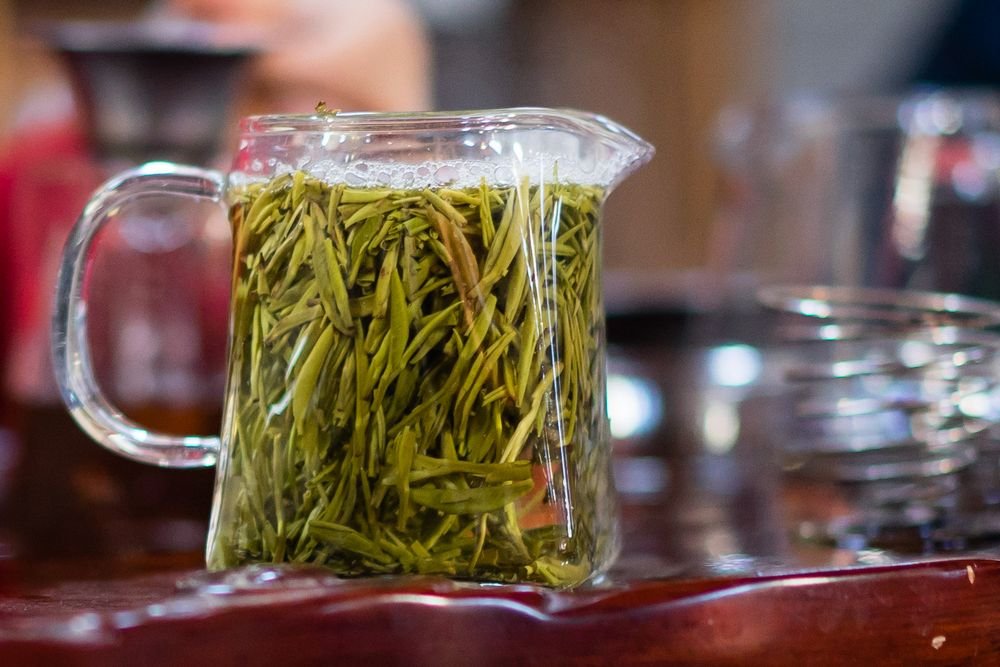
Both teas are best brewed in hot (not boiling) water. You can steep the tea for 2-3 minutes, or a little longer for a stronger flavor. Both varieties of tea are best consumed without milk. You can sweeten them with a bit of honey or add a dash of lemon.
Health Benefits
Both types of tea are extremely healthy. They are rich in antioxidants and catechins. Moreover, both contain a lot less caffeine than some other tea varieties.
Both jasmine and green teas are excellent tools for weight loss. Their antioxidant content can benefit the heart, lower the risk of certain cancers, and may even be used as a beauty tonic.
Advantages Of Jasmine Tea
Jasmine tea has several advantages:
- Mellow, floral flavor
- It can be a great entry-level tea that does not need sugar
- Boasts many health benefits, including those of green tea, if that is the base
Advantages Of Green Tea
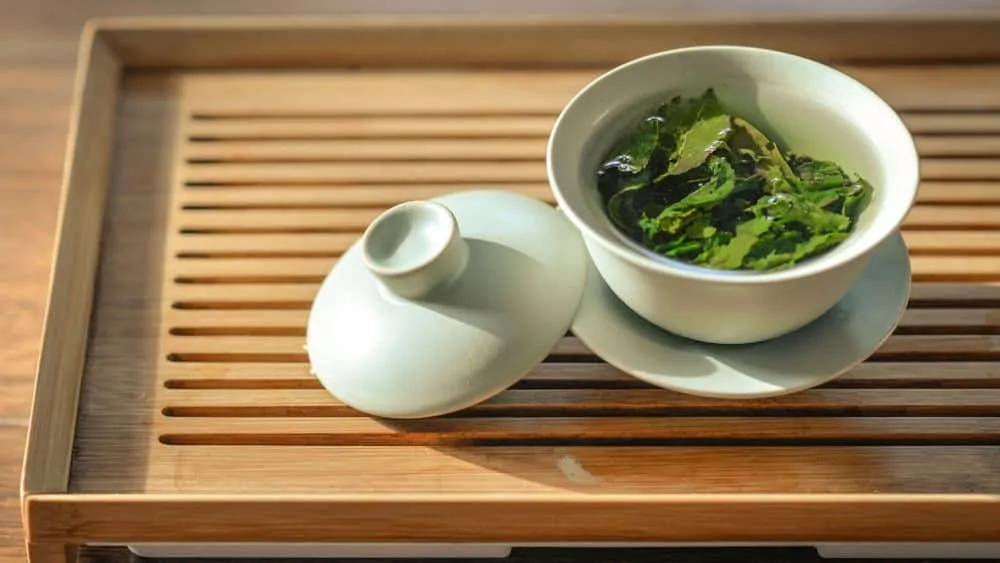
Green tea also has some advantages:
- Considered a super-food with numerous health benefits
- Cheaper than pure jasmine tea
- Available in a wide range of flavors
Reasons To Drink Jasmine Tea
Jasmine tea is a great choice for those who dislike the bitter, grassy taste of green tea. Many people love jasmine tea’s mellow and floral flavor.
The tea is also an excellent digestive aid and is ideal to serve after spicy meals. Jasmine green tea also has many health benefits, such as weight loss, heart health, etc., without the bitter flavor of green tea.
Pure jasmine tea is caffeine free. You can drink it in the evening without affecting your sleep.
You can learn more about jasmine green tea here, including specific teas I recommend.
We have a similar guide to jasmine silver needle tea here. That is the highest quality white jasmine tea (and a personal favorite).
Reasons To Drink Green Tea
Green tea is considered a super-food and numerous scientific studies have demonstrated its health benefits. The antioxidant-rich tea may aid in weight loss, benefit heart health, and even lower the risk of cancer.
Green tea is generally cheaper than pure jasmine tea. It is also available in a variety of flavors if you don’t like pure green tea’s bitter taste. Of course, one of those flavors is jasmine.
Learn more about green tea here, including the different varieties. The pages for each green tea variety have recommendations for good teas to get.
If you’ve unsure which variety to try, I’d go for a dragon well (guide here), if you’d like to try a Chinese roasted tea. If you’d like to try a Japanese steamed tea, go for sencha (guide here).
Is Jasmine Tea Green Tea?

Jasmine tea can be a type of green tea, but not always. If you’ve read through the rest of this article, you now know that jasmine tea can have any type of true tea as its base (green, white, black, oolong, yellow or pu’er). Green is the most common base, so most jasmine teas are green teas.
Of course, jasmine tea can also be nothing but jasmine flowers. In that case, it is not technically a tea at all, but a tisane.
Green Tea Vs Jasmine Tea: Final Thoughts
The most important thing we learned in this comparison of jasmine tea vs green tea is that most jasmine teas are, in fact, types of green tea. They are made by infusing green tea leaves with jasmine blossoms.
But not all jasmine teas are made that way. Some varieties use white tea leaves instead of green ones. Yet others use black or oolong or other types of true teas. And then there is pure jasmine blossom tea (again, not technically a tea).
One thing all of these types of jasmine tea have in common is that they taste great. Of course, I believe they have that in common with green tea as well, but if you do not like the taste of green tea, getting a jasmine flavored variety might be the answer for you.
Leave a Reply